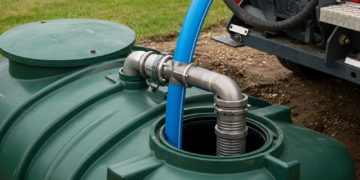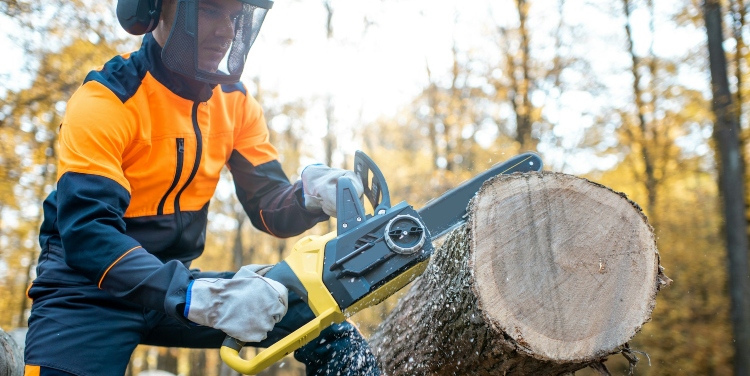A gas chainsaw works hard, and it needs regular care to stay in top shape. Dust, sap, and debris can build up fast, making the saw cut less efficiently and wear out sooner. To get the best results, it should be cleaned after every use and oiled each time the fuel tank is refilled. This simple routine helps the chain move smoothly and keeps the engine from straining.
Proper maintenance also saves time and money over the long term. A clean, well-oiled chainsaw starts easier, cuts faster, and lasts longer. Neglect, on the other hand, leads to dull performance and costly repairs.
This guide explains how often to clean and oil a gas chainsaw, along with the best ways to do it. By following a few consistent habits, anyone can keep their saw ready for any job and extend its working life.
Recommended Cleaning and Oiling Frequency
Proper cleaning and oiling keep a gas chainsaw cutting smoothly, prevent wear, and extend its life. Regular care removes debris that clogs parts and keeps the chain lubricated to reduce friction and heat.
How Often to Clean a Gas Chainsaw
A gas chainsaw should be cleaned after every few hours of cutting or at the end of each workday. Dust, sap, and wood chips can build up fast, especially in dry or dirty environments. Cleaning prevents buildup that can block airflow or dull the chain.
Focus on the air filter, bar groove, and sprocket cover. Remove sawdust from the cooling fins to stop overheating. A light brush or compressed air works well for this task.
For heavy cutting jobs or dense wood, increase the cleaning frequency. Operators who use high-strength steel chain gas chain saws often need to clean more often because these chains cut through tougher material that produces more residue. Always inspect the spark plug and clutch area since grime can affect performance.
How Often to Oil a Gas Chainsaw
Most gas chainsaws need oil on the bar and chain every 2–3 tanks of fuel. Some users prefer to add oil each time they refuel, which helps maintain steady lubrication. The goal is to keep the chain slightly wet with oil without dripping excess.
A dry chain creates more friction and can overheat or stretch. Check the oil level before each use and refill as needed. If the saw produces dry sawdust instead of moist chips, it may need more oil.
Use bar and chain oil designed for chainsaws rather than motor oil. It sticks better to moving parts and resists flinging off during use. Regular oiling also helps prevent rust and extends the life of the bar and chain.
Factors That Affect Cleaning and Oiling Schedules
Several conditions influence how often a gas chainsaw needs maintenance. Frequent use, dusty work areas, and cutting hardwoods all demand more cleaning and oiling. In contrast, light trimming in clean conditions allows for longer intervals.
Weather also matters. Cold temperatures can thicken oil, while heat can thin it out, affecting lubrication. Adjust oil type or frequency based on climate.
Chainsaw design plays a role too. Models with automatic oilers may need less manual attention, but the reservoir still requires checks. Keeping a regular schedule based on these factors reduces downtime and keeps the saw ready for work.
Best Practices for Cleaning and Oiling
A gas chainsaw performs best with regular cleaning and proper lubrication. Dirt, sawdust, and old oil can slow the chain and wear down parts, while clean components and fresh oil keep cutting smooth and safe.
Step-by-Step Cleaning Process
Start by disconnecting the spark plug to prevent accidental starts. Remove the bar and chain, then brush away sawdust and debris from the housing, sprocket, and air intake. A small, stiff brush works well for tight areas.
Wipe the bar groove and oil holes with a rag or thin tool to remove buildup. Clean the chain separately in a shallow pan of mild detergent and water, then dry it fully to prevent rust.
Check the air filter and replace it if heavily clogged. Clear any dirt from the cooling fins and around the carburetor. Once all parts are clean, reassemble the saw carefully and confirm that each component fits snugly before use.
Proper Oiling Techniques
A gas chainsaw needs two types of oil: one for the engine and one for the bar and chain. Use bar and chain oil that matches the saw’s design and local temperature. Thicker oil suits warm weather, while thinner oil flows better in cold conditions.
Fill the oil reservoir before each use and confirm that oil reaches the chain by running the saw briefly over a clean surface. A thin line of oil should appear, showing proper flow. If not, check the oil port for blockage.
Keep the chain slightly moist with oil during long cutting sessions. Refill the reservoir whenever refueling the engine. Clean oil passages regularly so the bar and chain stay lubricated and protected from friction.
Signs Your Chainsaw Needs Maintenance
A chainsaw that cuts unevenly or struggles through wood may need cleaning or oiling. A dry or smoking chain often signals poor lubrication. Unusual noise or vibration can also mean dirt buildup or low oil levels.
Inspect the chain and bar after each use. A dull chain, sticky residue, or visible wear on the bar’s edge shows that maintenance is overdue. Regular attention prevents these issues and helps the saw stay safe and effective for future work.
Conclusion
Regular cleaning and oiling keep a gas chainsaw in good shape and extend its life. Dirt, resin, and sawdust build up fast, so users should clean the tool after each use. A clean bar, chain, and air filter help the engine run smoothly and prevent wear.
Proper oiling also matters. The chain must stay lubricated every time the saw runs to avoid friction and damage. Users should refill the oil tank each time they add fuel and check for leaks before storage.
Consistent care saves time and money by reducing repairs. By following these simple habits, anyone can keep a gas chainsaw safe, efficient, and ready for work.
David Prior
David Prior is the editor of Today News, responsible for the overall editorial strategy. He is an NCTJ-qualified journalist with over 20 years’ experience, and is also editor of the award-winning hyperlocal news title Altrincham Today. His LinkedIn profile is here.














































































